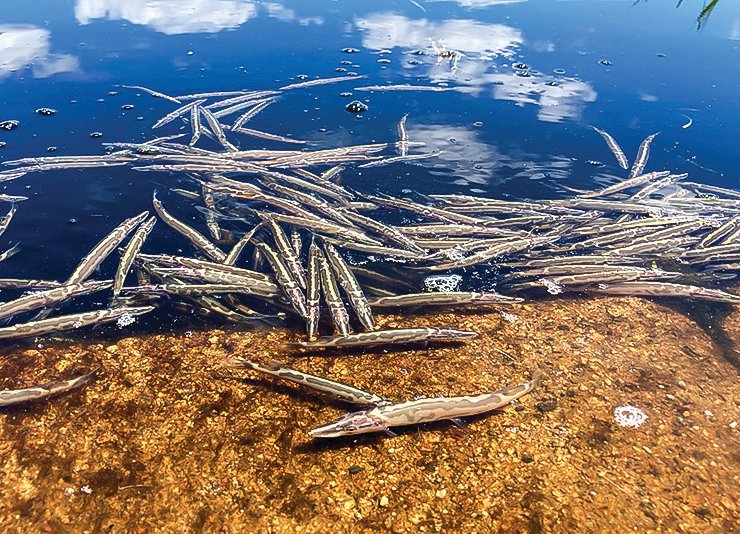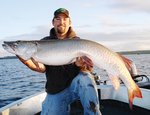Support the Timberjay by making a donation.
Different perspectives on Vermilion’s musky outlook
Heavy fishing pressure, new technology, may be changing musky behavior due to heavy pressure
LAKE VERMILION— It’s been good times for musky anglers here this summer, but could trouble be on the horizon? Matt Snyder, a longtime fishing guide who specializes in Lake Vermilion …
This item is available in full to subscribers.
Attention subscribers
To continue reading, you will need to either log in to your subscriber account, or purchase a new subscription.
If you are a current print subscriber, you can set up a free website account and connect your subscription to it by clicking here.
If you are a digital subscriber with an active, online-only subscription then you already have an account here. Just reset your password if you've not yet logged in to your account on this new site.
Otherwise, click here to view your options for subscribing.
Please log in to continue |
Different perspectives on Vermilion’s musky outlook
Heavy fishing pressure, new technology, may be changing musky behavior due to heavy pressure
LAKE VERMILION— It’s been good times for musky anglers here this summer, but could trouble be on the horizon? Matt Snyder, a longtime fishing guide who specializes in Lake Vermilion muskies, acknowledges that he’s had a successful summer, but says that’s thanks, in part, to new technology that has given the serious musky angler the kind of advantage they’ve never had before.
He says he’s seeing fewer younger fish, which usually show up as “follows” of the lures he and his clients are casting as they work the lake’s musky haunts. “The fishery as a whole is down,” he said. Snyder fears the current musky population is top-heavy with big, old fish, and that there aren’t enough younger fish coming in to replace those fish that inevitably die every year, whether the result of hooking mortality or simply old age. If so, he fears, musky anglers might not see the impact of that imbalance until it’s too late and he says more musky stocking could help recruitment of younger fish.
It’s an argument that Matt Hennen has heard before. Hennen is the DNR’s large lake specialist for Lake Vermilion and he agrees that the lake’s musky population may be skewed to big fish, but he’s not convinced that’s necessarily a problem for a catch-and-release fishery where anglers focus their efforts on trophies.
Hennen notes that the DNR began stocking Leech Lake strain muskies in 1987 with the goal of creating a low-density, high-quality opportunity for anglers who liked the thrill of latching onto a big musky. “If Vermilion does not meet that definition, I don’t know what would,” said Hennen. “If you can reasonably go out there and have the chance to catch the state record, that’s certainly meeting the goal.”
Hennen doesn’t disagree on the need for continued stocking, and the DNR has taken steps to maintain stocking levels even as the challenge of meeting an annual quota has increased. The DNR initially stocked 5,000 fingerlings from 1987-1994 in order to establish the population, with the expectation that natural reproduction would eventually reduce the need for stocking. Beginning in 1996, the DNR’s stocking plan called for the introduction of 5,000 fingerlings every other year, a pattern that continued through 2007, when the DNR dropped the biennial quota to 4,000.
Since 2017, the DNR has been trying to stock 3,000 fingerlings a year, plus up to 2,000 additional if surplus fingerlings are available. Most of those fingerlings on Lake Vermilion come from two rearing ponds adjacent to Wolf Lake, near Ely, and Hennen said, like most musky rearing ponds, the production can vary considerably. Young muskies, it turns out are happy to eat other young muskies and that can significantly reduce the number available at the end of the summer, when the rearing ponds are drained to remove the young fish for stocking. The DNR helps reduce that loss by providing sufficient forage, mostly minnows, for the young muskies, but the price of those minnows has gone up dramatically and availability has been a growing challenge as well. Hennen said the Tower DNR fisheries staff have started trapping some minnows themselves to keep the voracious muskies fed.
But the young muskies aren’t the only potential predators. Other, larger fish sometimes find their way into the rearing ponds, and they can devour a significant amount of the year’s production.
In most years, musky stocking efforts in any particular lake are limited to what’s remaining in their local rearing pond at the end of the season. But a select few lakes, known as “premier lakes” are guaranteed a quota, which gives them first rights to muskie fingerlings wherever they’re grown in the state. Under the management plan adopted by the DNR in 2018, Lake Vermilion is now one of those premier lakes, with a minimum quota of 3,000 fingerlings and up to 2,000 more over two years when surpluses are available. Since 2017, the DNR has stocked just over 15,000 musky fingerlings in Vermilion. The DNR stocked no musky in 2020 due to the COVID-19 pandemic shutdown during the egg-taking period.
At the same time, the DNR is now implanting what are known as “passive integrated transponder tags” in all of the musky fingerlings in an effort to better understand how the stocking effort contributes to the lake’s musky population. That should give the DNR useful information several years down the road, but until that data is available, the impact of the stocking is uncertain. “I wouldn’t expect we’ll start seeing those fish until 2027 or 2028,” said Hennen.
One of the open questions about the stocking effort is whether there is room in the population to allow for new recruits. In the early days of the musky stocking, there were no 50-inch-plus muskies roaming Lake Vermilion, eager to prey on just about anything that swims, including younger muskies.
“There’s only so much biomass that can be sustained,” notes Hennen. “The lake could be at some kind of carrying capacity for musky.” If so, it’s the big, older muskies themselves that are preventing the next generation from replacing them.
Changing behavior
There are other factors that may be playing a role as well. According to Snyder, the musky he’s seeing appear to be avoiding reefs, which have been the go-to spots for muskies for years. He said they’ve moved into deeper water and appear to be ranging much more widely than in the past. That could pose a huge challenge for a musky guide who is expected to be able to reliably put his clients on fish. That’s where the latest technology is making the difference. It’s called forward-facing sonar and it provides anglers with the ability to see fish live up to 100 feet away and even watch as they respond, or not, to the lures they cast in their direction.
The sonar is so effective it’s created a controversy among anglers who say it’s not fair to the fish. The Professional Musky Tournament Trail Tournament banned the use of the devices just last month after an uproar from participants in the tour.
Snyder said it’s changed his sport dramatically. “It’s not even fishing anymore. It’s road hunting,” he said. Using the sonar, he can systematically cover huge amounts of territory without ever having to wet a line. “I can just drive around and spot a musky, no problem.”
The experience of one of his clients shows just how things have changed. The guy had been all over the world catching every kind of fish imaginable, yet he had never caught a musky until he came to Lake Vermilion. Using his sonar, Snyder and his client cruised the lake until they spotted a lunker suspended in deeper water. His client hit the spot on the first cast and they both watched on the screen as the fish responded and struck. After a lengthy fight, they boated the big fish for the requisite photo before placing it back in the water.
“It used to be called the fish of 10,000 casts,” said Snyder. “Now, it’s the fish of one cast.”
At least for now. But as the recent behavioral changes suggest, musky are adaptable and there’s evidence they learn from their experiences. Snyder hypothesizes that the intense fishing pressure on Vermilion during the past two COVID-affected seasons may have helped push musky off the reefs, where they were hit hard.
While Hennen said he’d like to see more data, he agrees that avoidance behavior is certainly not unknown in fish. “They do learn and imagine how many times some of those big, old muskies have been hooked over the years on some of those reefs. “They’re naturally going to avoid them.”
The same thing may already be happening with the some of the latest technology. Snyder said he’s seen musky react aggressively to the “ping” they experience when they’re hit with sonar. He’s seen them jump from the water then dive down deep in an apparent effort to escape.
Such behavior wouldn’t surprise Hennen. “As a scientist, it’s tough to say for sure without data in hand, and behavior is tough to quantify. But at some point that fish has probably felt that ping and then been hooked,” he said. Which means the latest and greatest technology may prove effective only so long.
While technology has put some fish populations at risk from overharvest, that’s not going to be the case for musky, which are almost universally a catch-and-release fish. But unlike fish that are harvested, musky have the chance to learn from their mistakes and as the fish in a lake get older and wiser, the hunt for the lunker of a lifetime just may get more challenging.









